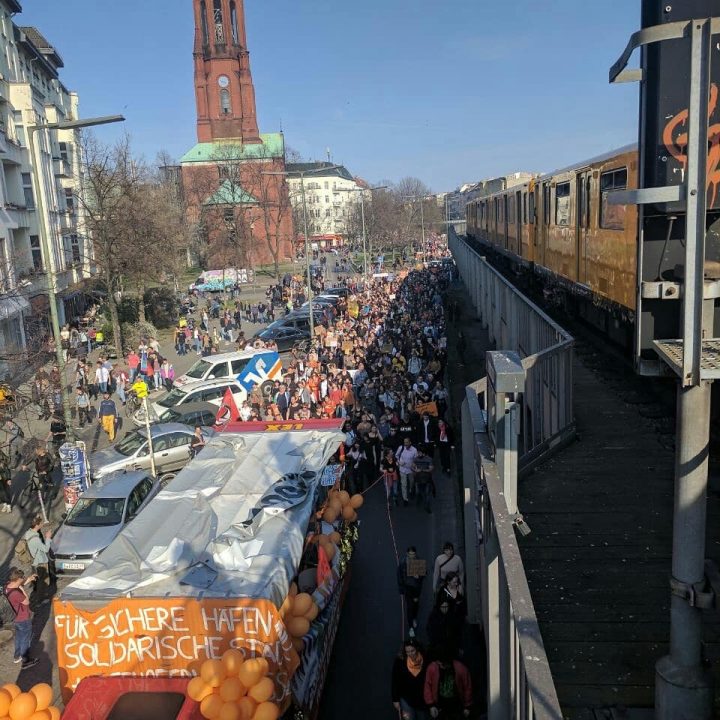With the EU deadlocked over migrant reception, the German Seebrücke movement offers a model for bypassing it.
This weekend, thousands of people marched in Berlin, and several other German cities including Nuremberg and Cologne, to protest a bill, proposed by the interior minister, Horst Seehofer, that would toughen the country’s asylum and deportation laws and criminalise pro-migrant activism.
The protest was not the first of its kind. Over the last few months, there have been several coordinated demonstrations over migrant policy across Germany. Between July and September last year, tens of thousands of people dressed in orange, many wearing life jackets, took to the streets to protest a growing clampdown on migrants attempting to cross the Mediterranean and the civil society organisations aiding them.
The demonstrations have been led by a new movement, called Seebrücke (German for ‘pier’, literally ‘sea-bridge’), which formed in response to the rising number of migrant deaths in the Mediterranean and the criminalisation of non-governmental sea rescue operations. Among the movements demands are for European governments to resume rescue missions, and offer safe and legal escape routes so refugees can exercise their right to seek asylum. The movement has called on municipal authorities to declare themselves a “safe harbour” for refugees in a show of solidarity.
The Seebrücke movement comes at a time when European governments are reneging on their previous commitments to sea rescue operations. The Italian sea rescue operation Mare Nostrum was launched in October 2013 after at least 360 migrants died when a boat travelling from Libya sunk off the coast of the Italian island of Lampedusa. However, only one year later, this operation was replaced by the European Union-led operation Triton – whose remit was focused on border control, rather than sea rescue. This operation, led by the European border agency Frontex, was supplemented by the military operation Sophia in 2015, which aims to combat smuggling networks. The prioritisation of anti-smuggling operations over search and rescue led to an increase in the mortality rate in Mediterranean, according to the Centre for Criminology at the University of Oxford.
The current European border regime in the Mediterranean is characterised by a nexus of militarised migration control and humanitarian rescue operations. The relationship between these two rationales has shifted dramatically in line with the political situation. In mid-2018, conflicts about sea rescue and refugee reception in the EU escalated to an unexpected degree, with the newly elected right-wing Italian government at the forefront of anti-migrant politics.
Both Operation Sophia, the EU’s anti-smuggling military operation, and NGO rescue ships like the Aquarius and Lifeline, have been impeded by Italian authorities refusing to allow migrants to disembark. Although one can speak of a rise of nationalism all over Europe, with other countries pushing anti-migrant politics and denying their responsibility of refugee reception as well, Italy holds a crucial role as the main country of entry to the EU through the central Mediterranean route.
Control and rescue in the Mediterranean Sea
The impasse over Operation Sophia sheds light on how the EU’s policies are falling short. In March, Sophia was extended for a year, however, it is now no longer allowed to deploy ships making it a naval operation without any boats. Far from being a sustainable solution, Sophia and Triton – despite their de-facto involvement in sea rescue – itself are part of the problem. Both operations were designed to combat smugglers, but the effectiveness of this strategy is questionable.
For migrants, however, the military operation has made Mediterranean crossing even more dangerous – a fact EU officials are quite aware of. It led to riskier routes for migrants trying to circumvent the militarised border and, in cooperation with Libyan forces, to serious human rights violations at sea and in detention centres on land. Meanwhile, the EU’s restrictive visa regulations and border regime, which in the first place makes it necessary for migrants to take such dangerous routes, is rarely challenged.
Nevertheless, in effect, Operation Sophia also worked as a rescue mission. While officially assigned to combat “human smuggling”, about 49,000 people have been rescued. In the first years of the operation, all of them were brought ashore in Italy. But since mid-2018, Operation Sophia has been hobbled by Italian authorities closing their ports to rescue ships. Germany withdrew its involvement in January, accusing the Italian commander responsible for the mission of intentionally sending ships to areas where there are no migrant vessels. As a result, only 106 refugees have been rescued since July. At the same time, other European governments have mostly refrained from offering










